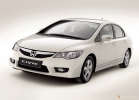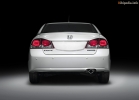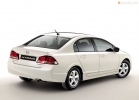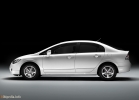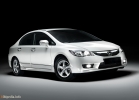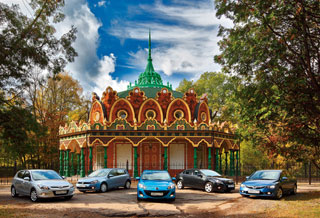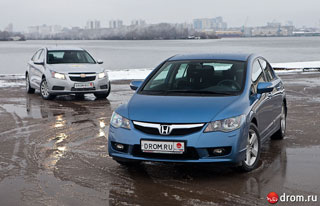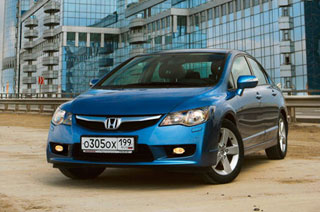Test drive Honda Civic sedan since 2008 sedan
New Honda Civic. Both fish and meat?
Many people like to talk about the cyclic nature of the story described the circle, it is repeated again. But I remembered this not at a lecture on philosophy, but at the presentation of the new generation of Honda Civic. The Hondians called the development of Sivik revolutionary evolution. And how do you order to understand? In search of an answer to this question, I left Malaga Airport, fingering the key to the green hatchback in my hand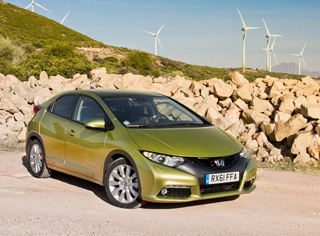
The new Civic is not so similar to the previous designers consciously chose an evolutionary approach. Yes, we are already accustomed to that Sivik, enthusiastically decreased, he no longer shocked those around him. But Civic fits perfectly into the line of Honda and does not look outdated
They are strange, these buyers. I remember that I had a long time of the sixth generation Civic. A two -leaf front suspension, a high -speed engine, sports habits. What else to wish for? But it turned out that most of the owners did not do this at all. They say, give a spacious salon and comfort. So the next Civic was born, which many immediately dubbed the offensive nickname the bus. And the character has diminished.

The most new Civic evokes associations with an Insight hybrid. He has not only a black insert on the face (resembles Seat Ibiza Bocanegra), but also a similar stern structure with large triangular lanterns and double rear glass. As for the dimensions that the Civic has added 35 mm in length, 10 mm wide, but the wheeled base ... decreased by 30 mm!
The Japanese naturally reacted. Six years ago, the Civic hatchback made a real splash. No one could even imagine that a car with such bold forms would reach the conveyor. And the space interior? Breakthrough! Yes, here is the bad luck to many by non -traditional design and salon and completely without leaving the indifferent, the current Civic turned out to be rude. Rushed off with tires, jumped on bumps and shied to the side in response to any deviation of the steering wheel. Plus a wayward robot. It is no wonder that he was replaced by a regular automatic during restyling.
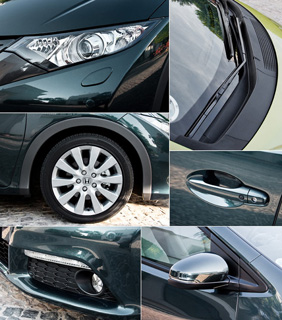
Door handles, mirrors, optics all this differs from the previous Sivik. Daytime running lights appeared. Pay attention to the Japanese again returned to the usual wipers, although the former Civic had swing brushes. And there were complaints about them, the wipers left too large unpeeled zones. The test machines were equipped with 17-inch wheels, xenon headlights and a comfortable access system
In search of an answer to the question of what they, the monsters, were necessary, the Hondians conducted a large -scale study and for four years they corked over the new car, rubbing their hands and anticipating the satisfied faces of customers. Completed? Judging by the first reaction at the Frankfurt car dealership, where the premiere of Sivik took place, many expected more. But did you need another revolution?

Yes, Sivik had a rear wiper! And, although the review back did not become better because of the massive stop-signal (and, part-time, also a spoiler) and the brush drive, in Russian conditions this is an undeniable plus.
When parking, the defects of the visibility are compensated for by the front and rear parking radars and the rear view camera, which transfers the image to the display of the central console. Her lens is near the license plate and is not covered by anything. That is, in the conditions of Russian winter, it will most often be useless.
Hidden rear door handles are uncomfortable, and even made of non -high -quality plastic
In addition, in natural conditions, the new Civic looks clearly better than in artificial lighting of the exhibition halls. The previous hatchback had a bunch of triangular thorns, and this one is woven from smooth lines flowing into each other. They say that the designers drew inspiration in seamless swimsuits for water sports, but we more like the association with airplanes. Moreover, Honda is related to aviation. No one will boast of a car like a swimsuit, right?
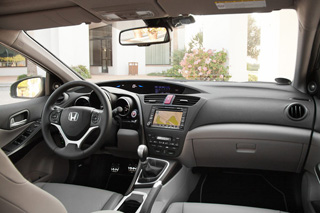
The interior is very convenient. You find everything at an intuitive level. By the way, last week we published the news that in the United States buyers are unhappy with the new generation of Civic sedan. They especially did not like the materials of the finish. So, in the European hatchback, very high -quality plastic is used. To give a complaint, to be honest, nothing.
The lateral mirrors became a little smaller and their shape has changed, but the main problem in the other in steep left turns the front stand greatly covers the review
The salon can be solved in two color solutions: both are presented in the photo
But genetics are evident. A take -off window sill line, highly located lanterns with a spoiler, dividing the rear window into two parts, almost identical proportions, hidden handles of the rear doors, we saw all this in the previous hatchback. However, Civic has become more calm and adult. Or maybe in a few years we are just used to the revolutionary Sivik.

The new climate control block successfully fit into the central console and is very convenient. Interestingly, in ECON mode, the automation itself controls the damper that covers air access from the outside. Thus, the air in the cabin is not diluted with warm streams from the outside, so the compressor air conditioner turns on less often.
The hefty touch screen, which seemed alien in the first published photographs of the new Sivik in reality, does not cut the eye at all. Combine multimedia has a navigation system and knows how to read audio files from the phone on the Bluetooth protocol. Display resolution 800x480
The pedals have both the car with mechanics and with an automaton. There are no complaints about the manual transmission. The lever has short moves and clear fixation
The same spirit is inside. The two-story front panel, the location of the deflectors, the gearbox lever and even the slots for CDs in the radio in the radio seems to be familiar. Apparently, this time the owners of the previous generation cars did not complain about the design. Yes, and we must admit that the salon of the former Sivik was very convenient, despite the riot of forms. The evolutionary approach is justified here.

The seats are very similar to the previous pillow, seem, and does not differ at all from the previous Sivik. But the driver now has an adjustment of side support embrace! And this will greatly delight smart drivers.
The reduced wheelbase did not affect the placement of people. There is enough space for the legs behind, but high passengers can complain about the pressure roof.
Four pulsed windows are still rare for some Japanese machines. Sivik has them
So where are the promised radical changes? Under the body, speak? To begin with, let's look at the hood and here is a gasoline atmospheric four with a volume of 1.8 liters. The power is increased by only 2 horses, now there are 142 of them, and the torque has not changed at all 174 N ∙ m at 4300 rpm. But do not rush to blame Honda engineers of idleness. The times were just that they are more concerned about carbon dioxide emissions, and not horsepower. And these emissions are 10% less (137 g/km), which complies with Euro-5 standards.
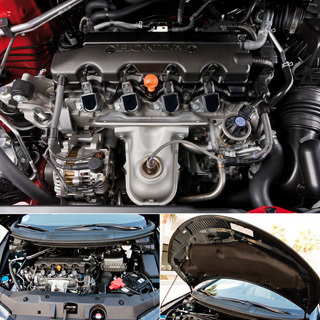
The modernization of a gasoline engine with a volume of 1.8 liters was environmental in nature. The material of the catalytic neutralizer has been replaced, the generator control system has changed, other spark plugs are used, and friction losses were reduced. The Idle Stop system is also introduced, which dramatizes the engine during stopping. It is only available with manual transmission, but it will not be represented in our market. In addition, the mass of the motor is slightly reduced due to the lightweight distribution and the radiator
Sadly? Only until the engine starts the Engine Start/Stop button! Civic breaks up with unexpected enthusiasm, and now we are already led off from the parking lot on the highway. If you are not lazy to wield a lever of six -speed mechanics and pamper the motor with high speeds, then from the place of Civic 1.8 it will accelerate in 9.1 seconds. A good indicator.

LED daytime running lights make the car more noticeable on the road
Spread Sivik is pleasant. And there is absolutely no need to get used to something. A well -tuned clutch, an excellent switch that is located exactly where the hand lies. Class! And the main surprise was that the atmospherician strangled by Euro-Norms willingly reacts to the actions of the accelerator. That's just the sound of the motor it itchs like a vacuum cleaner. Yes, and the steering wheel is empty, I would like more saturated feedback.
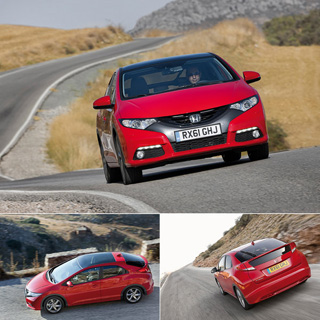
On winding paths, it is nice to drive on Sivica exactly he should be driving, moderately roll and pleases with correct reactions. But you need to get used to the light steering wheel and maintain a gasoline engine in tone, preventing the tachometer arrow from falling too much
Speaking of sound insulation. Inside, it became quieter than in the car of the previous generation does not pester the whistle of the cut air, the engine does not vote too much, but the rustle of wide 225 tires dominates. So the wheel arches, despite all the tricks, are still weak. But with a suspension, they worked very fruitfully Civic clearly added to the smoothness of the move! Moreover, in uneven areas, you can now rush without slowing down the energy intensity. This is very pleasing, because the former Civic on bad roads shaken his whole soul.

It is convenient to use all secondary functions, with the exception of the on -board computer. The Engine Start/Stop button does not need to be kept until the engine starts to press it 1 time
And what is this ECON button to the left of the steering wheel? Click! A green plant lit up on the dial of the fuel pointer. That's it, we began to save gasoline. We have nothing against the intellectual control of the climate control system, the system begins to use the air conditioner compressor less zealously and more often includes air recirculation to maintain the temperature inside. But the fact that the throttle damper changes the characteristics of the engine in favor of a smooth increase in torque is very noticeable on the highway.
The fact is that most of the way along the highways we went on active cruise control (ACC). Conveniently set +9 km/h to maximum allowed speed and you can forget about the police. But in the mountainous areas of the highway it often goes down and up. And in ECON mode, the car begins to lose speed on the ascent! Sometimes I had to switch not even to the fifth level, but to the fourth. However, we found the optimal algorithm simply turned off ECON when the road began to rise uphill. And if you take control and there is a desire to go quickly, then keeping the tachometer arrow needs to be closer to the number 4. Eh, it would be a turbocharged 1.4 or 1.6 and traction on the bottoms would be noticeably more, and it is easier to pay off from environmentalists. But while Honda does not have such units.

The volume of the trunk increased from 456 to 477 liters. True, this is the total volume taking into account the underground niche. If you fold the rear seats and load Civic under the ceiling, you get 1378 liters. In the right panel there is an audio system subwoofer. By the way, music plays excellent! Apparently, the owners of the former Siviks also asked for this, among whom there are many youth
We had a chance to travel by car with a machine gun. The engine is the same 1.8, and the five -iniapas gearbox is known for the previous generation sivik. Alas, we had just half an hour for this version, so in urban conditions we could not drive it. The first sensations of the positive box switching softly and adequately reacts to attempts to accelerate. In sports mode, she holds the current gear longer and uses the lowered ones more actively. In addition, she can be controlled with the help of steering wheel petals. But the dynamics deteriorates from 9.1 to 10.9 seconds to hundreds.

The machine gun selector and its modes differ from the previous Sivik. Now there are no D3, 2 and 1 that limit switching within these steps only ordinary D and sports S. It is for the better. Another absolutely logical solution is manually transmitted exclusively to the steering wheel petals. For there is no need for the possibility of switching a lever in this case
The day ended in thoughts. The new Civic turned out to be calmer than the former not only externally and inside. He became quieter, smoother, a sharp, clearly expressed sporty character was smoothed. And then I was dawned on the scenario of the change of generation of Sivica, cleaned up from the new chord! He, too, said bright features in an effort to please everyone. At dinner, Honda representatives confirmed my guesses. And they quote Mitsur Karia, a person who owes the life of Civic 2012 model year: the European consumer wants a safe, easy to drive and an affordable car. And, it seems, it turned out.

There are many containers for small things in the Sivic salon. A 12 volt socket and a lace for connecting USB devices are hidden in the armrest. Panoramic glass roof in the equipment list
Yes, here they are, the new values \u200b\u200bof Honda. And what, aren't you yourself wanted? I don't like the sharp steering wheel, we will save you from this problem. The tough suspension is straining okay, we will softer, but just try to complain about the rolls! Noisy? Add kilograms of insulation. Large fuel consumption? Here you have ecological toys. But in the morning, my pessisim completely disappeared on the final part of the route, we chose diesel Civic.
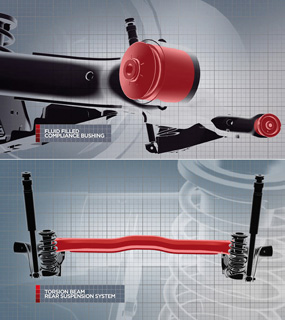
The suspension scheme of the new Sivik has not fundamentally changed. In front of the rack MacPherson, a torsion beam with tied levers at the back. But the beam became tougher (its thickness increased by an average of 2.5 mm), and the silent blocks of attaching longitudinal levers became hydraulic. Like the flagship sedans Honda Legend and Acura RL! In addition, a new steering rack appeared the number of revolutions from the stop to the stop increased from 2.2 to 2.47, provided that there are 17-inch wheels on the car. And at the base 16-inch revolutions will already be 2.62. In the diesel version, the numbers are different 2.66 (R17) and 2.81 (R16)
If we returned 15 years ago and said that the hottest Civic would have a diesel engine, we would have looked at us, either with surprise, like aliens, or with compassion, as on mentally unhealthy people. What diesel? VTEC, 9000 revolutions and forward! But the harsh reality is the Civic 2.2 I-DTEC on both shoulder blades puts the gasoline version. Moreover, after modernization, its power increased from 140 to 150 horsepower.
There is no need to focus on the characteristic plasticity of the motor on idle or small vibration. It is better to immediately move off and go to the mountain serpentine. Yes, diesel Civic is heavier than gasoline as much as 158 kg (1363 versus 1205), but it not only quickly accelerates (8.5 ss to 100 km/h) and has a non -350 N ∙ m. The steering wheel is saturated with effort, the suspension is tougher. Yes! What you need!

A lot of attention is paid to Sivica aerodynamics, the Japanese declare a decrease in the air resistance coefficient by 10.8% for a gasoline version and 12.6% for diesel. What is the difference? The diesel Civic has automatic shutters in the radiator grill, which are closed when additional cooling is not required (recall, diesel engines operate in a different heat mode than gasoline). In addition, there are small wings on the rear wings of the Civic 2.2 I-DTEC
Attack the turns and studs in high. The motor confidently drags Civic uphill, and the gearbox does not force to constantly switch due to the narrow working range typical of diesel engines at the second stage, the engine smoothly hangs on the cutting of 93 km/h. The main thing is not to lower the speed below 1700, when the turbine has not yet had time to give the necessary pressure. Otherwise, lose not only traction, but also receive the vibration massacer of the seats, the motor expresses dissatisfaction with a noticeable vibration. I liked the very intelligent work of the stabilization system, VSA acts extremely unobtrusively, allowing to slip a little. But, of course, it beats the ruler on the hands, if you completely lose your head.

The Japanese explain the reduction of the wheel base and, accordingly, the increase in the posterior overview. Changed dimensions allowed to fit into the rigid requirements of crash tests imitating the blow from behind. Perhaps this will positively affect the lateral blow. However, the previous Sivik took a test of the Euro NCAP association for the five. Moreover, already according to the new rules
And also diesel civic, of course, is more economical. If the gasoline consumed about 7 l/100 km on our route, then the diesel fuel went less than 6 l/100 km. It is a pity that diesel is still not for Russia. The reasons for this are the mass of the cost of gasoline and diesel fuel, and the cold climate, and diesel versions are much more expensive than gasoline. For example, in the UK (where all Civic hatchbacks are produced for the European and Russian market) The difference between 1.8 I-VTEC and 2.2 I-DTEC reaches almost 1800 euros. And we will have it even more because of customs duties depending on the volume of the engine.

The CMBS system (Collision Mitigation Brake System) operates in combination with active cruise control (ACC) and is designed to soften the consequences of a collision. It works at a speed of 15 km/h, and the principle of action is as follows: the radar scans the space in front at a distance of 100 meters. If CMBS recognizes the probability of an accident, three seconds before that it gives the driver sound and visual signals. If there was no reaction, CMBS begins to slow down the car and makes three jerks with a seat belt. And the third stage is independent inhibition and bringing passive security systems into combat readiness. In Russia, CBMS and ACC will not yet be offered much to rest on the used radio frequencies, and our movement is too chaotic, additional tests are required
We will not have a base 100-horsepower engine with a volume of 1.4 liters. However, the loss can certainly be small about him. So the main shock force is still 1.8 with mechanics and automatic in three trim levels (Elegance, Sport, Executive). On sale, the car should appear with us in March-April. True, now rumors about possible delays in connection with a flood in Thailand, where a large factory of the company, which produces not only cars for the Asian market, but also many components, is located, is increasingly more actively. However, the Hondians make every effort so that this does not affect the debut of the novelties.
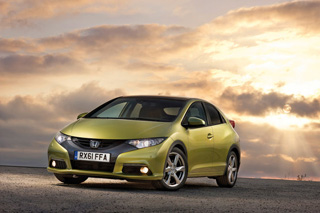
Perhaps not everyone will like that the new Civic no longer has pronounced character traits. But he definitely became better, more comfortable and older. Neither fish nor fowl? Rather, both fish and meat!
They promise that prices will not change much. Recall that now Civic 1.8 costs from 849 rubles for modification from manual transmission to 969 thousand for the most sophisticated version with an automatic machine, glass roof, xenon headlights, leather salon and other joys. And finally, we were intrigued with information that the Civic sedan for the Russian market will appear very soon. Moreover, he must get on sale almost earlier than the hatchback. But he has not yet been presented! Well, we will wait for the details.
Vadim Gagarin
Photo by the author and company Honda

STORY
It will be difficult for many to believe, but the history of the Civic model began even earlier than the universally recognized leader of the class with Volkswagen Golf! If the hatchback from Wolfsburg was registered on the factory conveyor in 1974, then the Khondovskaya smaller was presented to the public a couple of years earlier in 1972.
First generation (1972-1983)
The first generation of the machine is a masterpiece of design and design thought, to put it mildly, it is difficult. On the contrary, the first sivik turned out to be unpretentious and technically simple: front-wheel drive, a 50-horsepower 4-cylinder motor with a volume of 1.2 liters, a 4-speed mechanics (as an option, however, a robotic box of Hondamatic was also proposed). However, a simple, light, and most importantly reliable and inexpensive machine fell in love with motorists, not only Japanese, but also European. Many auto industry historians consider Civic the first machine from Japan, which was able to make serious competition of the products of the European auto industry. The Japanese also accepted the ocean: Siviks exported to the USA and Canada, and in the territory of the States the base version was sold for a modest $ 2200. The first generation of the Khonda small drafts in the bodies of two-, three- and five-door hatchbacks was also produced, the station wagon was also present in the range.
Second generation (1978-1983)
The second generation car was based on the platform of its predecessor. The choice of bodies became more traditional (only hatchback, sedan and station wagon remained in the gamut), the motors are more powerful and economical (55-horsepower 1.3 and 67-horsepower 1.5), and the gearboxes are more reliable and modern (5-speed mechanics were added, and Hondamatic became 3- stepped). In Europe, the second Civic with a slightly modified appearance was sold under the name Ballade.
Third generation (1983-1987)
Having increased the wheel base by 125 mm, the company's engineers made a new Sivic much more attractive for the buyer: choosing an inexpensive small -leaf, the motorist received a car close in dimensions to the chord! True, the choice of engines remained not rich: 60-horsepower 1.3 and 76-horsepower 1.5, a pair of which were 4- and 5-speed mechanics and a 5-band machine. By the way, it was the third generation of the car (in particular, cars with a universal body) for the first time tried on all -wheel drive. In Europe, this generation of the machine was offered under the names of Honda Ballade and Rover 200.
Fourth generation (1987-1995)
If outwardly the fourth Civic actually repeated the predecessor, then the mechanical filling has changed very much. Firstly, many modifications with all-wheel drive appeared, secondly, the cars of this generation equipped with a completely independent suspension, and thirdly, the Honda engineers created a technically advanced 16-valve engine that developed from 62 to 92 hp. With a working volume of 1.3-1.5 liters. In 1987 (for the first time for compact cars!), Civic received engines on which the VTEC system debuted, changing the gas distribution phases and regulating the degree of valve opening. In addition to the hatchbacks, the Shuttle station wagon (today such a car would be called compactwhen) and CRX compacter went off the assembly line.
Fifth generation (1991-1996)
With the change of generations, Civic increased in dimensions, added capacities, gained modern security systems, became more friendly to the environment ... And instead of the average hatchback, customers finally offered a stylish car, although before that the design of the cars was not the strength of the Japanese company. However, now, thanks to an extraordinary appearance, not only mature motorists who appreciate, first of all, comfort and reliability, but also youth, paid attention to the new Sivik.
Sixth generation (1996-2001)
The most stylish, most organic and most beloved by the Hondavods Sivik. In addition to motors that meet the then hard California environmental norms and a pretty appearance, the sixth generation was remembered by contemporaries and a new modification, a Type R car with a Schildik received a lightweight body, reconfigured in the calculation of gambling drivers and steering, enhanced brakes, a differential of increased friction and 185-horsepower 1 , A 6-liter engine. This hatchback was loved not only by the ralists and ringers, but also to burn simple lovers for all the money, making a real icon of motorsport from Sivik.
Seventh generation (2000-2006)
On the seventh Sivik, the designers decided to abandon the front suspension on double transverse levers and installed McPherson racks, thus obtaining both the increase in the space in the motor compartment and a decrease in the cost of the machine. A new line of engines also appeared, and the rear passengers now pleased the absolutely even floor. But the technical surprises did not end there: the new generation Sivik was serial in serial with a hybrid power plant combining a 65-horsepower gasoline engine with a volume of 1.3 liters and a 13-horsepower electric motor. And the high -speed Type R received a forced two -liter atmosphere, which in the European version developed 200 forces, and in the version for the domestic market everything is 215! In addition, he was offered to the Japanese with a differential of high friction
Eighth generation (2005-2011)
Those who scolded the seventh generation of Sivik for a modest appearance and a boring character, received in full when they made his hatchback of the eighth generation: the aggressive front of the novelty made in a deliberately futuristic style, forced to pay attention to the Honda not only loyal fans of the brand, but also all motorists who who are whose motorists The equally dull representatives of the S. segment were tired, the Hondians were rebuilt and made the sedan more modest so as not to scare away the conservative part of their customers. And they did not lose! By the way, the version for the United States (sedans and coupe was sold) differed from European and externally and constructively: there was an independent biashole on the state cars from behind, and a twisting beam in Europeans.
Alexey Kovanov
Source: Auto.mail.ru

